Boats are meant to go on and off trailers – at the ramp, that is. And while the boat is in the water, it’s pretty easy to give the trusty trailer a once over to see that all is well.
While a quick check is fine, there can be circumstances that will require more detailed work on the trailer and might see the boat off the trailer for quite a while, in closer proximity to tools and materials. Cleaning up and then re-painting a trailer, which I did when my boat returned from Weipa on each occasion, is a prime example of the necessity for a boat and trailer to part company. In this article, you’ll see just how easy it is to remove and then return the boat to its trailer. Note that the trailer will remain connected to the car until the boat is totally off it and on a bed of tyres.
Old car tyres are never hard to find with the number required depending upon the length of the hull and it’s shape. Generally speaking, the boat needs to be supported firstly at the stern as it’s coming down off the trailer, and then on the sides as the trailer is moved from under it. I used six tyres in the example shown with my 4.3 Bullshark. The same number of tyres worked just as well with the 5.5 Galeforce when we replaced the brake system. Ever tried replacing a brake system with the boat on the trailer? Forget it! Also, removing the boat from the trailer is best as a two-person project to make things easier.
Tyres sorted, the next job is to move the transducer/s out of harm’s way. If, like myself, you have gone to some trouble to get the transducer just right on the back of your alloy craft, you might like to tape a straight edge under the hull, showing just how the transducer’s aligned and then photograph it for later reference, before moving it out of the way. This saves you frustration later. The outboard needs to be tilted up as far up as possible and a tyre placed at the transom area for the skeg to sit on.
Before doing anything further, consider the general area where the boat is being removed from the trailer. It’s important to be able to bring the trailer back in perfect alignment with the hull when the boat needs to come back on it, so there has to be enough space for the car to be reversed straight back to the boat with trailer at the ready. Alternatively, the trailer needs to be lined up straight and then the car connected to the trailer. In practice, later, you will see why this is stressed as important.
With transducers taken care of, the next task is to sit three tyres under the transom area ensuring that the transducer will not make contact with them as the boat is coming off the trailer, which is a totally manual exercise. A push will start to move the boat backwards. Move it only a small amount at a time by controlling the amount of slack in the winch cable for the duration of the exercise. Providing slack in the winch line by disengaging the winch pawl, pulling out a bit of cable, then again engaging the pawl is the way to go.
Control is everything; you don’t want the boat slipping back quickly or jarring down hard. Take heart, it’s very easy to control that rear movement as the amount of winch cable provided governs the rearwards movement of the boat. Once the boat is moving backwards in small controlled stages, it’s time to start working out where the tyres need to be to support the hull. A bit more movement – under careful winch control – will make it pretty clear where the hull is going to come down to the ground. With the tyres carefully aligned, the hull can be moved backwards even further so that the stern dips down off the trailer to see the hull resting correctly on them and extending nicely skywards on the back of the trailer.
This next bit involves both a car driver and a winch supervisor. The car driver will be moving the vehicle very carefully forward a few centimetres at a time, to move the trailer out from under the boat while the winch is also strategically disengaged to provide slack at all times, otherwise the poor old boat will be dragged forward. Again, make sure the placement of tyres is correct when it’s obvious that the boat is coming off the trailer. You can easily halt everything and take a look at where things are going.
The winch operator will be able to make this assessment and this is why I advocate moving the car forward just a small amount at a time while the winch cable is carefully disengaged to provide slack. By proceeding slowly, and with care, the boat will come off that trailer without even a jar or bump, and (I might add) with some satisfaction for the participants! Congratulations, you have the boat off the trailer and you can work on it at leisure.
Work completed, we need to get it back. That’s the next step.
The only tricky bit here is to get the trailer absolutely square on to the tow hook of the boat before doing anything else. I usually do this with the trailer disconnected. Once the trailer is perfectly in alignment, bring the car back to the trailer and connect it. If the trailer is out of perfect alignment, the boat will come up in a badly misaligned manner. In the water, it will swing to correct itself. Sitting hard on the tyres, it can’t do this. Things soon go pear-shaped once the car moves forward. It starts with the boat moving to an edge of the first roller and gets progressively worse. Don’t go there!
With the winch connected and someone on the winch to watch state of play, use it to pull the boat up as the car is carefully and slowly reversed to the point where the trailer is just engaging the hull.
Now comes the best bit and it’s a process that works quite easily. As the transom is perched hard on the three rear tyres, the boat won’t move backwards. The car will when the winch is used. How? Rather than reversing the car, which might cause an issue with power, the car is left out of gear and with hand brake off. With each winch handle revolution, the trailer and car move backwards quite easily to see the boat rising as the trailer goes under it. The trick is to keep winding that winch handle. You won’t need to check things like when the boat was coming off, so long as the boat is going onto the trailer as straight as it should be.
While it might sound involved, it’s not. I have done this with the 5.5 fibreglass Galey at least three times and the Bullshark just as many times. There has never been a drama. Once the boat is horizontal on the trailer, it comes forward very readily and the exercise is complete.
Reads: 12281
The job ready to go – tyres can be moved in exactly where the hull will touch the ground.

Protect those transducers. These ones are safely up out of the way.
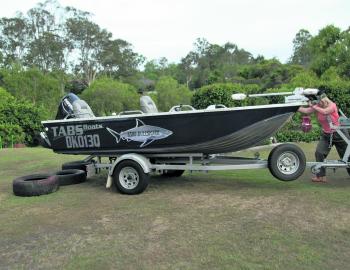
With a good trailer, the boat won’t take much effort to shift back. Denise is moving it fairly easily. Note the controlled amount of slack in the winch cable.
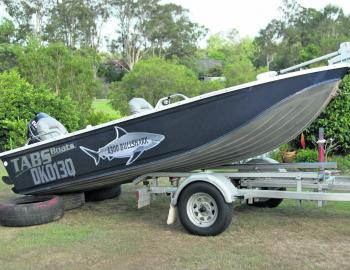
At this point, the hull and tyres need to be placed exactly right, so go slow.
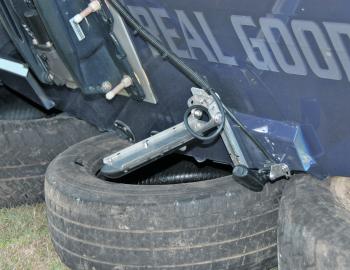
With careful placement, the transducers are out of harm’s way.
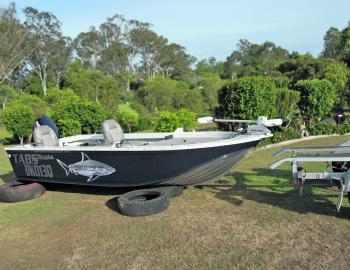
The car is driven forward very slowly as the tyres for the sides of the hull are aligned. Then the job’s done and the trailer is ready for any work.
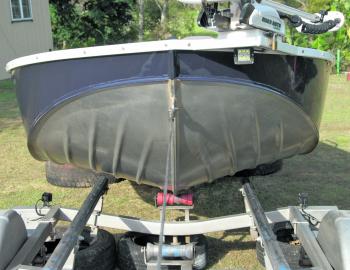
Perfect! The hull is moving up onto the trailer as the trailer and car are reversing back.




